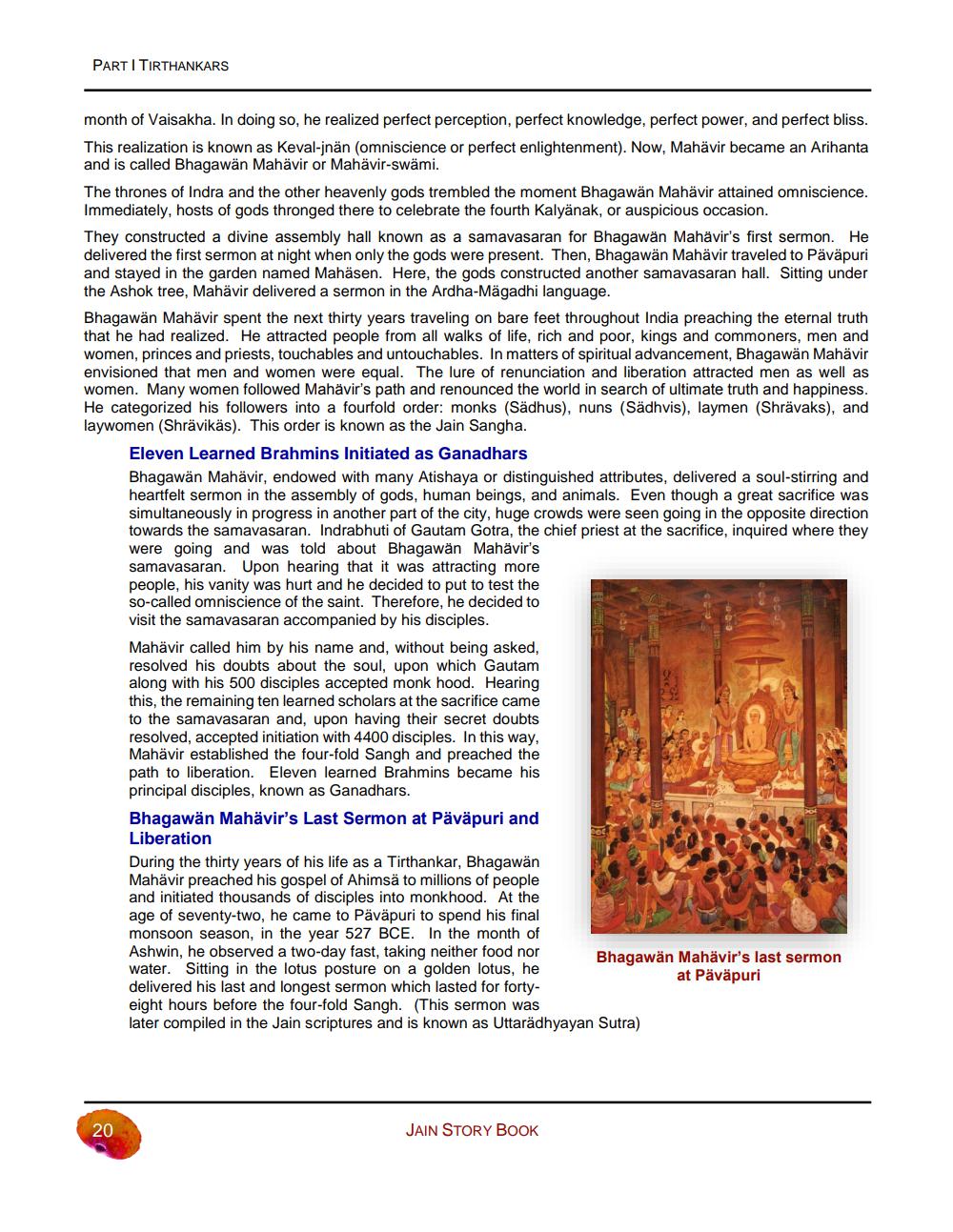________________
PART I TIRTHANKARS
month of Vaisakha. In doing so, he realized perfect perception, perfect knowledge, perfect power, and perfect bliss. This realization is known as Keval-jnän (omniscience or perfect enlightenment). Now, Mahävir became an Arihanta and is called Bhagawan Mahavir or Mahävir-swämi.
The thrones of Indra and the other heavenly gods trembled the moment Bhagawan Mahavir attained omniscience. Immediately, hosts of gods thronged there to celebrate the fourth Kalyänak, or auspicious occasion.
They constructed a divine assembly hall known as a samavasaran for Bhagawan Mahavir's first sermon. He delivered the first sermon at night when only the gods were present. Then, Bhagawän Mahävir traveled to Päväpuri and stayed in the garden named Mahäsen. Here, the gods constructed another samavasaran hall. Sitting under the Ashok tree, Mahävir delivered a sermon in the Ardha-Mägadhi language.
Bhagawan Mahavir spent the next thirty years traveling on bare feet throughout India preaching the eternal truth that he had realized. He attracted people from all walks of life, rich and poor, kings and commoners, men and women, princes and priests, touchables and untouchables. In matters of spiritual advancement, Bhagawän Mahävir envisioned that men and women were equal. The lure of renunciation and liberation attracted men as well as women. Many women followed Mahävir's path and renounced the world in search of ultimate truth and happiness. He categorized his followers into a fourfold order: monks (Sädhus), nuns (Sädhvis), laymen (Shrävaks), and laywomen (Shrävikäs). This order is known as the Jain Sangha.
20
Eleven Learned Brahmins Initiated as Ganadhars
Bhagawan Mahavir, endowed with many Atishaya or distinguished attributes, delivered a soul-stirring and heartfelt sermon in the assembly of gods, human beings, and animals. Even though a great sacrifice was simultaneously in progress in another part of the city, huge crowds were seen going in the opposite direction towards the samavasaran. Indrabhuti of Gautam Gotra, the chief priest at the sacrifice, inquired where they were going and was told about Bhagawan Mahavir's samavasaran. Upon hearing that it was attracting more people, his vanity was hurt and he decided to put to test the so-called omniscience of the saint. Therefore, he decided to visit the samavasaran accompanied by his disciples.
Mahävir called him by his name and, without being asked, resolved his doubts about the soul, upon which Gautam along with his 500 disciples accepted monk hood. Hearing this, the remaining ten learned scholars at the sacrifice came to the samavasaran and, upon having their secret doubts resolved, accepted initiation with 4400 disciples. In this way, Mahävir established the four-fold Sangh and preached the path to liberation. Eleven learned Brahmins became his principal disciples, known as Ganadhars.
Bhagawän Mahävir's Last Sermon at Päväpuri and Liberation
During the thirty years of his life as a Tirthankar, Bhagawän Mahävir preached his gospel of Ahimsä to millions of people and initiated thousands of disciples into monkhood. At the age of seventy-two, he came to Päväpuri to spend his final monsoon season, in the year 527 BCE. In the month of Ashwin, he observed a two-day fast, taking neither food nor water. Sitting in the lotus posture on a golden lotus, he delivered his last and longest sermon which lasted for fortyeight hours before the four-fold Sangh. (This sermon was later compiled in the Jain scriptures and is known as Uttarädhyayan Sutra)
JAIN STORY BOOK
Bhagawän Mahävir's last sermon at Päväpuri




